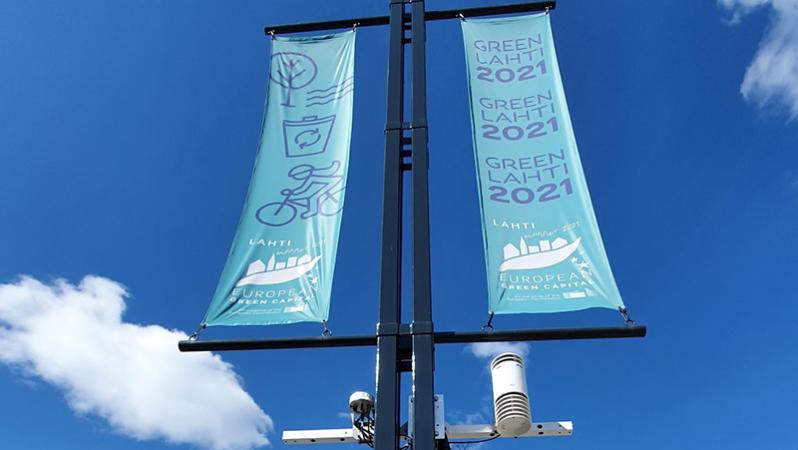Our mission: cleaner air in Lahti
Vaisala’s solution for air quality monitoring in cities is based on accurate and cost-effective compact air quality sensors. In the Lahti European Green Capital 2021 project, the city of Lahti will be measuring air quality in the city area and analyzing the data from the air quality sensors that have now been installed in the city in May.
Why is air quality monitoring important, and why does the city of Lahti want to improve their monitoring? Kaarina Kähäri, environmental engineer in Lahti, provided us with interesting insights into this very topical issue.
Vaisala is one of the partners in the Lahti European Green Capital 2021 project. What kind of objectives do you have for the project overall?
One of the central goals of Lahti’s European Green Capital 2021 project is building partnerships between different operators. In order to address environmental challenges, we need new forms of collaboration between the private and public sectors and civil society. There will also be sustainability actions in many different industries during the year.
Our next bigger air quality target in Lahti is to decrease emissions from wood burning by households, which hasn’t been researched too much yet in the Lahti region. Polycyclic aromatic hydrocarbon (PAHs) can be released into the air during the burning of fossil fuels, garbage, or other organic substances, as well as when wood doesn’t burn fully (e.g. wet wood).
We have also been active in decreasing the amount of street dust, especially during spring time. When the temperature is below freezing at night and above freezing during the day we always get a lot of street dust due to sanding of the streets. Hence, we have paid attention to street cleaning and dust suppression.
Vaisala and Lahti are working together to show a great example of how an air quality monitoring solution can work at its best. What are the key benefits for cities for setting up such system?
Citizens have a right to know what kind of air they are breathing. Overall, we have good air quality in Finland, also here in Lahti. It is important that we are able to monitor and measure air quality as a trend – to know how it’s developing. Particularly in the spring, it is vital particularly for people with asthma and respiratory disorders, for example, to get air quality information. They can then decide when and where to go jogging or if they need to take more medication to ensure that they continue feeling well.
Ambient air quality is naturally affected by emissions from various sources, such as traffic, power plants, industrial facilities, and fireplaces in households. In Finland, all municipalities are obligated to know on what level the local air quality and emissions are. We have been measuring air quality in Lahti since the 80’s.
In Finland, the air is naturally very clean. What are currently the main issues with air quality in Lahti?
The basic level of air quality here is good and the challenges are encountered only periodically, which differs from most of Europe. It is important to implement actions tailored for the local needs. An individual’s viewpoint is a great example: bad air quality affects some people more than others so we need to be keep different health issues in mind.
We have the same air quality measurement guidelines throughout Europe, which means the results are comparable. However, it is vital that we are able to determine the best solution for our needs on local level so we receive the data we need here.
You have placed the air quality sensors on the Lahti market square and on the intersection of Aleksanterinkatu ja Vesijärvenkatu. Why did you select these locations?
Both of these locations have busy traffic as well as pedestrians who breathe the air that we monitor. We are very interested in finding out what air quality is like in the city center. Previously, we have had one long-term monitoring station in Vesijärvenkatu, which we had to close. Lahti is located in between hills which means that the city is inversion prone – this is one of the reasons why we wanted to have air quality sensors in the city center. Due to these inversions, for example, there may be higher than normal nitrogen oxide levels for a shorter periods of time, which is not visible in average numbers. However, people will notice the difference there and then.
Vaisala’s compact air quality sensors are easy to install. There is no need for permission or to consider pedestrian or traffic safety issues as the sensors can be installed on lamp posts, for example. This means we will be able to have more locations where citizens are able to see air quality information.
If you would consider having an additional sensor where would you move it?
As said, our focus is very much on our citizens. It would be great to have a mobile air quality sensor that we could take to a location where people have reported local air quality issues. It would be interesting to research also data from a specific residential area for even a shorter period of time. This would provide us – and our citizens – even better in obtaining relevant additional data.
You can find further information on Vaisala and the Lahti European Green Capital 2021 project on our website.


Add new comment